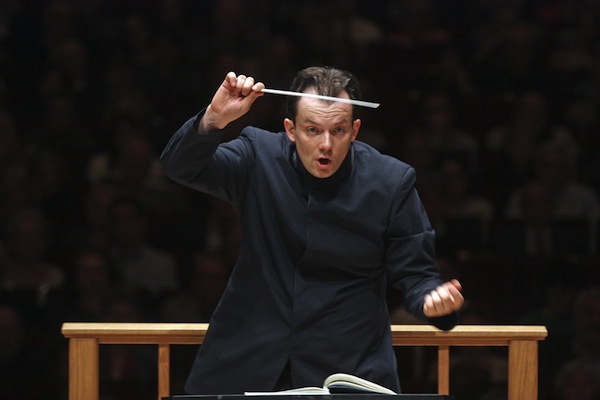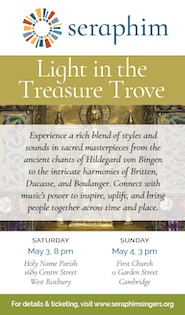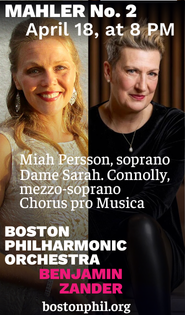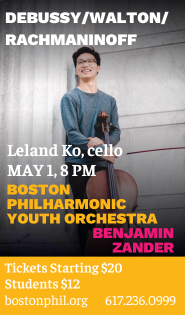Nelsons, BSO deliver power and precision in Bernstein and Shostakovich rarities
Andris Nelsons returned to Symphony Hall Thursday night to kick off his final residency of the Boston Symphony’s season. He brought with him two symphonies, both the products of near-thirty-year-old composers of the mid-20th century that are at once expressively immediate and strikingly different.
Leonard Bernstein’s Symphony No. 2, “The Age of Anxiety” dates from 1949. Based on W. H. Auden’s eponymous 1947 poem, it traces a journey from spiritual alienation to a resolution that’s full of hope, even if the concluding bars have the feel of a 1940s Hollywood score. Still, it is a tightly-woven piece, unified by a theme that is constantly varied across the work’s two Parts (“The Seven Ages” and “The Seven Stages”) and six movements.
Perhaps its most striking feature is the prominent inclusion of a piano. When Serge Koussevitzky and the Boston Symphony Orchestra gave the world premiere of “The Age of Anxiety” at Symphony Hall in 1949, the composer was the soloist; on Thursday, BSO artist-in-residence Jean-Yves Thibaudet took the role.
Thibaudet’s technique is excellent and his command of Bernstein’s style was total. His performance of the high-voltage keyboard part was both assured and crafted with remarkable care. The first Part’s set of fourteen variations were rhythmically sharp and bright-toned. The “Dirge” of Part II sang with soulful weight, while “The Masque” made for a (slightly measured) blast. Thibaudet imbued the cadenza in “The Epilogue” with glowing sincerity.
For his part, Nelsons drew a snappy performance with shapely, lustrous playing from the orchestra. The contrast between piano and ensemble was always striking, nowhere more so than in the passages in “The Seven Ages” that explored the sonic space between the piano playing in the stratosphere and the orchestra grunting from its depths. Thibaudet was never covered, and tempos were well-judged, apart from some deliberate transitions.
Written in 1936 but withheld until 1961, Dmitri Shostakovich’s Symphony No. 4 is a dissonant, abstract, and sprawling work, as free and inventive an approach to the genre as “The Age of Anxiety” but writ on a much larger canvas.
Its massive first movement is a mélange of conflicting styles and gestures that has a stream-of-consciousness quality to it. There are marches, waltzes, and a fugue, among other things. Sometimes the music is terrifying; at others it’s cheeky, banal and ironic.
The second movement, by contrast, is a grim, often grotesque, waltz whose second theme anticipates the opening movement of Shostakovich’s Fifth Symphony. A sardonic funeral march begins the finale and an icy coda closes it; in between come episodes that recall the first movement: dance tunes, ditties, and the like.
On Thursday, Nelsons held the Fourth Symphony’s disparate elements together in a performance of ferocious intensity; the tension never slackened during the score’s seventy-minute duration. The resulting interpretation of this challenging work marked, perhaps Nelsons’ most satisfying Shostakovich performance in his ongoing cycle to date—fresh, unpredictable, lacking in pretense, and brimming with color.
The orchestra consistently dug into the score’s slashing extremes. Climaxes (especially in the first movement) were often savage: at one apex, the percussion nearly drowned out the brass playing fortissimo.
The first-movement fugue was taken at a blistering clip and the ascending woodwind canon in the second movement sounded deliriously woozy.
At the same time, the music’s delicate moments came across with immediacy. The eerie conclusion to the second movement, with percussion ticking like a time bomb, was gripping, as were the celesta patterns at the end of the finale. Among a host of fine solos, those by Robert Sheena (English horn), Tom Rolfs (trumpet), and Toby Oft (trombone) stood out.
After the last note faded, Nelsons held the silence for more than half a minute. The public responded with a thunderous ovation.
The program will be repeated 1:30 p.m. Friday and 8 p.m. Saturday and Tuesday at Symphony Hall. bso.org; 888-266-1200.
Posted in Performances




